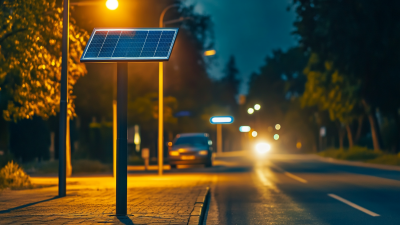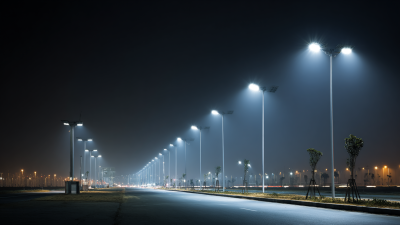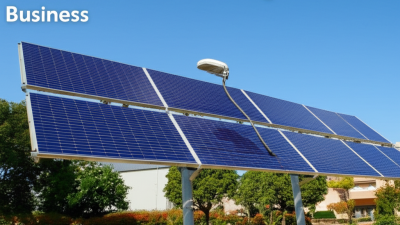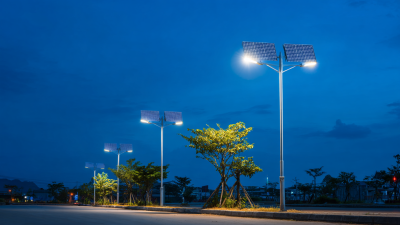News
Discover the Best Solar Street Lamp Solutions for 2025 Top Digital Trends
As urban areas continue to expand and the quest for sustainable energy solutions becomes increasingly urgent, the spotlight is turning to innovative technologies like solar street lamps. These environmentally friendly lighting solutions not only promote energy efficiency but also enhance public safety and aesthetic appeal in our cities. In 2025, we can expect to see a surge in advancements surrounding solar street lamps, driven by emerging digital trends and a growing commitment to sustainability.

The integration of smart technology into solar street lamps is set to revolutionize urban lighting. From adaptive brightness controls to real-time monitoring systems, these modern lamps will not only illuminate our roads but also contribute to data collection efforts that can improve city planning and infrastructure development. Understanding the wide-ranging benefits and functionalities of solar street lamps will be essential for municipalities and urban planners aiming to navigate the rapidly evolving landscape of urban lighting solutions.
In this exploration of the best solar street lamp solutions for 2025, we will delve into the latest trends in technology, design, and energy efficiency. By understanding the potential of solar street lamps, stakeholders can make informed decisions that align with their sustainability goals and improve the quality of public spaces in their communities.
Innovative Features to Look for in Solar Street Lamps for 2025
As we move towards 2025, the evolution of solar street lamp technology is set to enhance urban lighting solutions significantly. One of the most notable innovative features to look for is the integration of smart sensors. These sensors can adjust brightness based on surrounding light conditions and pedestrian movement, thereby conserving energy while providing optimal illumination when needed. This adaptability not only extends the lifespan of the lamps but also reduces energy costs for municipalities.
Another crucial advancement is the incorporation of IoT (Internet of Things) connectivity. Solar street lamps equipped with IoT capabilities allow for real-time monitoring and management through a centralized system. This enables city planners to gather data on usage patterns and maintenance needs, ensuring that the lighting infrastructure remains efficient and responsive. Moreover, features such as remote diagnostics can preemptively address issues, minimizing downtime and maintenance costs.
Lastly, enhanced sustainability features, such as recyclable materials and advanced solar panel technology, are becoming vital components of solar street lamps. These innovations ensure that the lamps not only provide eco-friendly illumination but also contribute to a circular economy. By choosing solar street lamps with these forward-thinking features, cities can pave the way for a brighter and more sustainable future.
Top Digital Technologies Transforming Solar Street Lamp Efficiency
The evolution of solar street lamp technology is significantly influenced by the latest digital trends, aimed at enhancing efficiency and reducing energy consumption. According to a recent report from the International Renewable Energy Agency (IRENA), the integration of smart technologies in solar street lighting systems can increase energy efficiency by up to 30%. This improvement is achieved through the implementation of intelligent motion sensors and adaptive lighting controls that adjust brightness based on pedestrian presence, thereby minimizing energy waste.
Moreover, advancements in IoT (Internet of Things) technology facilitate remote monitoring and maintenance of solar street lamps. A study by the Global Smart Lighting Association revealed that cities utilizing IoT-enabled solar street lamps experience a decrease in operational costs by approximately 20%. These systems not only provide real-time data on energy consumption and lamp conditions but also allow for effective troubleshooting, ensuring a longer lifespan and consistent performance of the lighting infrastructure. As urban areas increasingly adopt these smart solutions, the future of solar street lamps looks bright, promising sustainable and cost-effective lighting solutions for city planners worldwide.
Trends in Solar Street Lamp Efficiency for 2025
How to Choose the Right Solar Street Lamp for Your Community in 2025
Choosing the right solar street lamp for your community in 2025 requires careful consideration of several key factors, including efficiency, technology advancements, and community needs. According to a recent report by MarketsandMarkets, the global solar street lighting market is expected to grow from $1.1 billion in 2021 to $4.8 billion by 2026, representing a compound annual growth rate (CAGR) of 33.7%. This growth reflects the increasing reliance on renewable energy sources and the need for sustainable urban infrastructure.
When selecting solar street lamps, it's essential to evaluate their specifications, such as brightness levels and solar panel efficiency. Current technology enables solar panels to harness up to 20% more energy compared to those produced a few years ago. Additionally, smart features like motion sensors and adaptive brightness can significantly enhance safety and energy efficiency. A study by the International Energy Agency indicates that communities implementing smart solar lighting systems have witnessed a 30% reduction in energy consumption, making it not only cost-effective but also beneficial for the environment.
Finally, engaging with community members during the decision-making process can yield valuable insights into preferences and requirements, ensuring that the chosen solar street lamps meet local needs. Integrating feedback mechanisms, like surveys or community meetings, helps to foster a sense of ownership and support for these green initiatives, thereby paving the way for a more sustainable future.
Emerging Trends in Solar Street Lamp Design and Functionality
As we head into 2025, the solar street lamp industry is witnessing innovative design and functionality trends that reflect a growing emphasis on sustainability and smart technology integration. According to a report by ResearchAndMarkets, the solar street lighting market is expected to reach USD 11.46 billion by 2026, growing at a compound annual growth rate (CAGR) of 20.2%. This signifies a robust adoption of solar solutions that not only enhance urban aesthetics but also promote energy efficiency.
Emerging designs are increasingly focused on multifunctionality, with features such as integrated environmental sensors and smart city connectivity. For instance, many modern solar street lamps are now equipped with IoT capabilities, allowing for remote monitoring and real-time data collection. This shift not only improves operational efficiency but also supports proactive maintenance, which can reduce costs by up to 30%, as highlighted by the International Energy Agency. Moreover, the integration of LED technology continues to enhance energy consumption, providing over 50% more efficiency compared to traditional lighting solutions.
These trends underscore a transformative period for solar street lamp technology, reflecting broader societal goals of environmental responsibility and urban innovation. The emphasis on smart solutions highlights the potential for solar street lamps to play a pivotal role in developing sustainable urban infrastructure, setting a benchmark for future deployments.
Discover the Best Solar Street Lamp Solutions for 2025 Top Digital Trends
| Feature | 2025 Trends | Functionality | Design Innovations |
|---|---|---|---|
| Smart Sensors | Adaptive lighting based on pedestrian traffic | Energy saving and enhanced safety | Sleek modular designs |
| Solar Efficiency | Higher conversion rates with new photovoltaic materials | Extended runtime | Minimalistic aesthetics |
| Connectivity | Integration with IoT platforms | Remote monitoring and control | Varied finish options |
| Durability | Weather-resistant features | Reduced maintenance | Stylish protective casings |
| Sustainability | Recyclable materials usage | Lower carbon footprint | Nature-inspired designs |
Maximizing Energy Savings: Tips for Smart Solar Street Lighting Solutions
As urban areas continue to evolve, solar street lighting has emerged as a sustainable solution for cities looking to enhance energy efficiency while ensuring public safety. The advancement of technology in solar energy has made it possible to maximize energy savings significantly. Here are some essential tips for implementing smart solar street lighting solutions effectively.
First, consider the integration of smart sensors that adjust the brightness of street lamps based on the surrounding light levels and pedestrian traffic. By using motion detectors, street lamps can dim during low-traffic periods, conserving energy while still providing adequate lighting when needed. Additionally, implementing remote monitoring systems can help city planners track energy usage and maintenance needs, further optimizing efficiency and reducing long-term costs.
Another effective strategy is to select high-quality solar panels and batteries that withstand different weather conditions. Investing in durable materials not only extends the lifespan of the solar street lights but also enhances their performance. Combining these elements with energy-efficient LED bulbs can drastically improve overall energy savings, as LEDs consume significantly less power than traditional lighting. These smart solar solutions not only align with global sustainability goals but also contribute to the creation of smarter, more resilient cities.
Related Posts
-

Advantages of Choosing the Most Efficient Solar Street Lights
-

Solutions for Innovative Best Solar Street Lights to Enhance Urban Safety
-

Maximizing Savings with Exceptional After Sales Support for Best Solar Panel Street Lights
-

5 Essential Tips for Selecting the Best Commercial Solar Street Lights for Your Business
-

Innovative Solutions for Illuminating Outdoor Spaces with Solar Street Lights
-

How Solar Street Lamps are Revolutionizing Urban Lighting and Enhancing Sustainability
